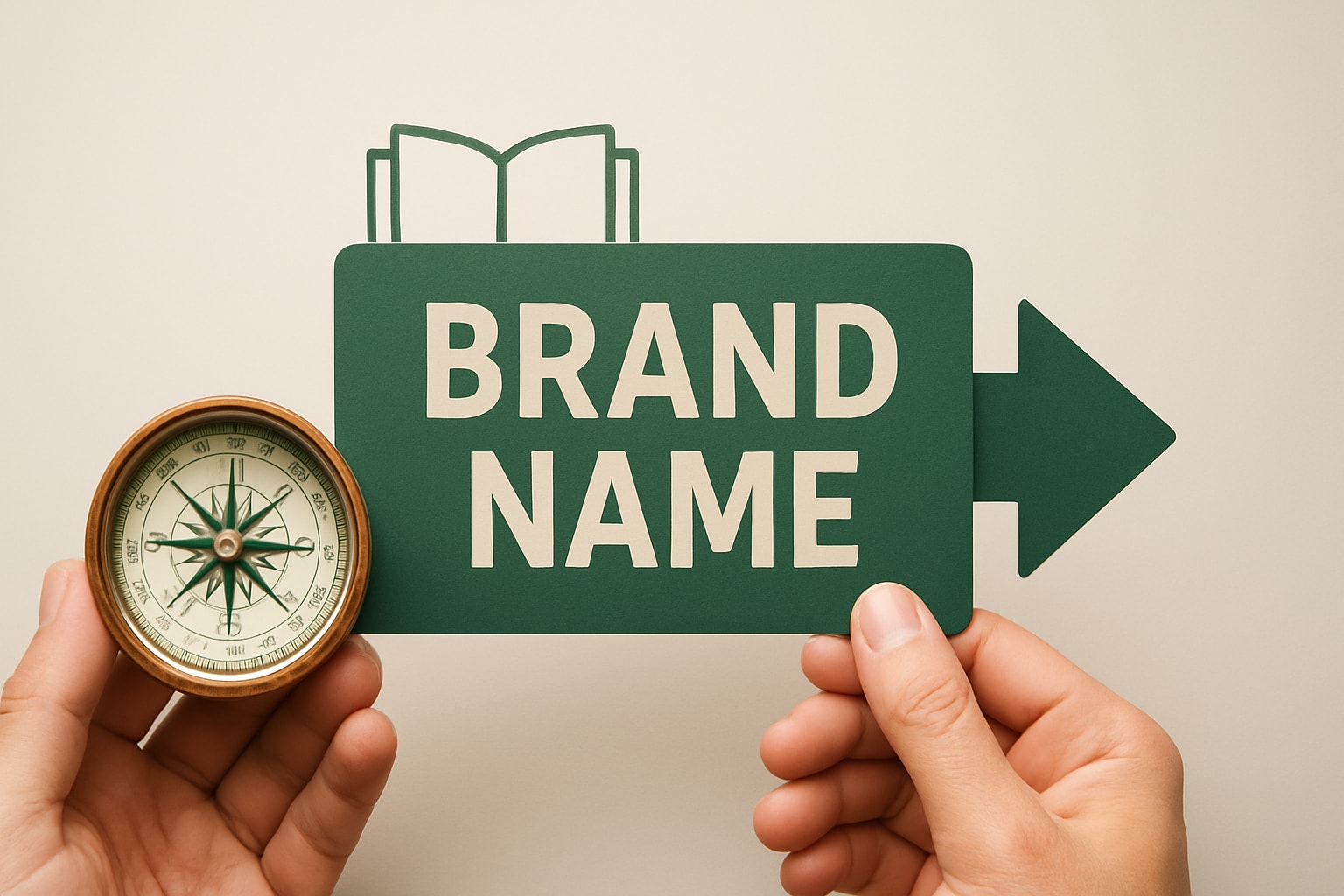
Brand Name Guide: Your Essential Handbook for 2025
In 2025, standing out starts with your brand name. Competition is fierce, and recent studies reveal that 77% of consumers make buying decisions based on name recognition alone. The right brand name builds instant credibility, sticks in memory, and inspires trust from the first impression.
If you’re a founder, marketer, or business leader, this is the guide you need. Here, you’ll find clear, actionable steps to craft, test, and secure a future-proof brand name. We’ll cover the psychology of naming, creative techniques, legal and digital essentials, and the trends shaping tomorrow’s most memorable brands.
The Fundamentals of Effective Brand Naming
Creating a strong brand name is both an art and a science. It’s more than a label; it’s the first handshake, the first impression, and often the reason customers remember or forget you. Effective brand naming starts with understanding the psychology behind names and extends to mastering the details that make a name stick.

The Psychology Behind Brand Names
A brand name shapes how people feel and what they expect before they even interact with your product. Think about the emotional pull of Apple, Nike, or Tesla. These names aren’t just words, they spark curiosity and trust. Studies show that names with positive associations are easier to remember and recall, which builds familiarity and affection over time.
A memorable brand name can create an instant connection. When people hear it, they might picture quality, excitement, or innovation. That’s why the right brand name is a bridge between your vision and your audience, making your story easier to tell and your mission easier to believe.
Key Elements of a Strong Brand Name
What makes a brand name stand out? It comes down to memorability, simplicity, distinctiveness, and relevance. Ideally, your brand name should be easy to say and spell, making it simple for customers to share and recall. In fact, 65% of top-performing brands use names with three syllables or fewer.
A strong brand name also fits your market and matches your values. It feels natural in conversation and looks good in a logo. If you’re launching a business, Launching a new brand guide offers insights into why the right name matters at every stage, from ideation to launch. The best names are the ones people can’t forget—even after hearing them only once.
Types of Brand Names: Approaches & Examples
There are many paths to finding the right brand name. Here’s a quick comparison:
Each approach has its strengths. Descriptive names make intent clear, while invented words can be playful and unique. Acronyms and founder names add backstory and credibility. The right type depends on your goals and the story you want your brand name to tell.
Cultural and Linguistic Considerations
A brand name that works in one language might flop in another. Chevy Nova is a classic example—“no va” means “doesn’t go” in Spanish, which sent the wrong message in Latin America. Missteps like this can be costly.
To avoid embarrassment or confusion, test your brand name across languages and cultures. Look for hidden meanings, awkward pronunciations, or negative associations. Use local advisors or online tools to vet your name before you go global. The best brand names cross borders gracefully, building trust wherever they go.
Common Mistakes to Avoid
Many businesses fall into the same traps when choosing a brand name:
- Picking something too generic, so it blends in and is easily forgotten.
- Making it overly complex, which confuses or alienates customers.
- Overlooking what the brand name means in other languages or cultures.
- Ignoring digital availability, leading to conflicts with domains or social handles.
- Skipping trademark checks, risking legal trouble down the road.
Avoid these pitfalls by taking your time, doing the research, and listening to feedback. A thoughtful approach can save you from costly mistakes and set your brand name up for long-term success.
Step-by-Step: How to Develop a Winning Brand Name in 2025
Building a winning brand name in 2025 is a journey, not a sprint. Every step matters, from vision to validation. Let’s walk through the process, so you can shape a name that stands the test of time.

Step 1: Define Brand Strategy and Audience
Start with clarity. What is your brand name meant to represent? Define your vision, mission, and core values first. These are the compass points for every decision that follows.
Next, get specific about your audience. Build out personas that reflect not just demographics, but also desires, frustrations, and buying behaviors. Who are you really speaking to? What words or moods resonate with them? A brand name that aligns with your strategy and connects to your audience will always have more staying power.
Step 2: Brainstorming & Ideation Techniques
Now the creative work begins. Gather your team and use mind mapping or word association to spark ideas. Sometimes, the best brand name emerges from unexpected places.
Don’t be afraid to experiment. Creative workshops allow for free flow of thoughts, while AI-powered naming tools can help you break through mental blocks and explore combinations you might miss on your own. The key is volume—generate many options, then refine.
Step 3: Shortlisting and Initial Vetting
From your brainstorm, create a shortlist. Evaluate each brand name for relevance to your mission, uniqueness in your industry, and potential to grow with your company.
Ask your team for honest feedback. Does the name feel right? Is it easy to say and remember? Uniqueness is critical—according to 74% of consumers prioritize unique business names, standing out directly impacts engagement. Filter ruthlessly until only the strongest contenders remain.
Step 4: Linguistic, Cultural, and Global Screening
A brand name that works in one language may falter in another. Use multilingual tools to screen for unintended meanings or negative associations across markets.
Look at real-world examples—brands like the Chevy Nova struggled due to translation issues abroad. Consult native speakers or cultural experts if you plan to go global. This step prevents costly missteps and safeguards your reputation.
Step 5: Legal and Trademark Research
Before you fall in love with a brand name, check its legal status. Search national and international trademark databases such as the USPTO and WIPO.
It’s wise to consult a trademark attorney early. Securing the rights to your brand name now can save you from expensive disputes later. If the name is taken or too similar to another, go back and refine your shortlist.
Step 6: Digital Availability and Domain Checks
The digital landscape is crowded, so secure your online presence early. Start by checking if your brand name is available as a .com domain. If not, consider alternatives like .io or .co.
Don’t forget social media handles—consistency across platforms builds credibility. Studies show 89% of startups secure digital assets before launching, knowing that digital availability is as vital as the name itself.
Step 7: Testing and Validation with Real Audiences
Finally, put your brand name to the test. Use A/B testing, surveys, or focus groups to gather real feedback from people who match your audience profiles.
Ask direct questions. Is the name memorable? Does it evoke the right feeling? Use this input to refine your choice. If your top pick falls flat, revisit earlier steps until you land on a brand name that truly resonates.
Digital Era Essentials: Securing and Protecting Your Brand Name Online
Owning your brand name online is more than a checkbox, it is the backbone of your digital presence. In 2025, the digital landscape is crowded and fast-moving. Securing your brand name across every digital touchpoint is a non-negotiable step for leaders who want to protect their reputation, reach, and future growth.

Domain Strategy for 2025
Choosing the right domain for your brand name in 2025 is a strategic decision. While .com remains the gold standard, alternatives like .io, .ai, and industry-specific TLDs are gaining traction. Many founders secure multiple domains to protect their brand name from competitors and cybersquatters.
Common domain strategies include:
- Prioritizing .com for global credibility
- Registering relevant new TLDs for innovation
- Acquiring premium or aftermarket domains for uniqueness
Staying ahead means watching the latest Top business name trends for 2025 to understand how naming conventions shift online.
Social Media Handle Consistency
Consistency across social platforms strengthens your brand name and makes it easier for customers to find you. Unified handles prevent confusion and help build trust from the very first interaction.
Key steps for social media handle consistency:
- Use the same handle across all major platforms
- Check availability early in the process
- Utilize tools like Namechk or KnowEm for quick checks
A consistent brand name presence on social media is foundational for recognition and recall.
SEO Implications of Brand Names
A well-chosen brand name can influence your search rankings and click-through rates. Search engines favor unique, memorable names that are easy to spell and pronounce. Brandable names often outperform generic or keyword-stuffed options in organic results.
Consider the following:
- Short, memorable names improve direct traffic
- Unique names reduce competition in search results
- Keyword-rich names can help but may limit long-term brand growth
Balancing creativity and discoverability is essential when choosing a brand name for SEO success.
Preventing and Managing Brand Name Infringement
Brand name infringement is a real threat in the digital era. Proactive monitoring and swift action are required to protect your assets and reputation. Use tools that alert you to potential trademark or copyright violations across domains and platforms.
Steps to manage infringement:
- Set up alerts for unauthorized brand name use
- Respond quickly with cease-and-desist notices
- Consult legal professionals when needed
Taking ownership of your brand name online means always staying vigilant and ready to defend your identity.
Building a Digital Brand Asset Portfolio
A complete digital asset portfolio shields your brand name from impersonators and confusion. Secure variations, common misspellings, and defensive domains to maintain your online territory. Ongoing management ensures you are prepared for future pivots or expansions.
Best practices for portfolio building:
- Register all relevant domain variations
- Secure social handles, even if unused
- Regularly review and update your asset list
Protecting your brand name online is a continuous investment in your business’s future.
Trends & Innovations in Brand Naming for 2025
Brand name strategies in 2025 reflect a landscape shaped by rapid change, new technologies, and shifting consumer values. Let’s explore the trends driving the next wave of brand name innovation.

AI and Machine Learning in Name Generation
AI has become a trusted partner for founders seeking the perfect brand name. In 2025, top platforms like Namelix, Squadhelp, and Copy.ai offer advanced algorithms that generate hundreds of name options in seconds. These tools analyze market trends, linguistic data, and even emotional cues to suggest names with high memorability and global appeal.
The real power of AI is in its ability to break creative blocks. Founders who once spent weeks brainstorming now use AI to spark fresh ideas and test concepts quickly. This shift frees up time for deeper strategic work and ensures the brand name resonates in a crowded digital world.
Inclusive and Ethical Naming Practices
Modern consumers expect brands to reflect values of inclusion and respect. The brand name you choose in 2025 must avoid stereotypes, cultural insensitivity, or exclusionary language. Companies now use diverse focus groups and cultural vetting tools to spot potential issues before launching a name.
Some brands set the bar high by involving community voices early in the naming process. This approach builds trust and connection, especially in global markets. Ethical naming isn’t a trend, it’s becoming the new baseline for lasting, positive brand impact.
Sustainability and Purpose-Driven Naming
A growing number of businesses choose a brand name that signals their mission or environmental values. Research shows that 61% of Gen Z consumers prefer brands with a clear purpose. Names that evoke sustainability, care, or social good stand out in competitive markets.
For example, the Brand Finance Global 500 2025 report highlights leading brands who have successfully aligned their name with their mission, strengthening loyalty and recognition. In 2025, a purpose-driven brand name is not just a statement, it’s a magnet for conscious consumers.
Minimalism and the Power of Simplicity
Minimalist brand names are winning attention for their clarity and recall. One-word names like Bolt, Calm, and Stripe cut through the noise and stick in the mind. Short names are easier to pronounce, spell, and remember, making them ideal for global audiences.
Minimalism is more than a design choice. It’s a philosophy that values essence over excess. When founders distill their vision into a single, striking brand name, they make it easier for customers to connect, share, and advocate for the brand.
Future-Proofing: Adaptability for Emerging Markets
A future-proof brand name is flexible enough to grow with your business. As companies expand into new markets or pivot their offerings, adaptable names help avoid costly rebrands. Smart founders choose names that transcend trends, languages, and categories.
Case studies from tech and consumer brands show that those who plan ahead—checking for linguistic fit and scalability—are better positioned for global success. A future-ready brand name is an investment in resilience, relevance, and long-term value.
Real-World Examples and Lessons from Top Brands
Choosing a brand name is more than a creative exercise. It’s a high-stakes decision that shapes perception and drives loyalty. Let’s explore real-world lessons from brands that have navigated this journey—sometimes brilliantly, sometimes not.
Case Study: Successful Brand Naming Stories
Some brand name choices instantly connect with their audience and stand the test of time. For example, “Airbnb” transformed from a niche concept into a global hospitality leader. The name is simple, memorable, and hints at the core service—air mattresses and bed-and-breakfast stays.
Another standout is “Spotify.” The name is easy to say, easy to remember, and uniquely positioned for digital music discovery. Both brand name examples became household words and set the tone for their industries.
According to the "Brand loyalty survey: 48% stick with favorite brands", a strong brand name is often the first step in building lasting consumer trust. The lesson? A name that resonates can become a foundation for loyalty and long-term value.
Case Study: Naming Failures and What Went Wrong
Even major players stumble with brand name choices. Consider the launch of “New Coke.” Despite huge investment, the new name failed to capture the emotional attachment customers had with the original Coca-Cola, leading to a quick reversal.
Then there’s the infamous “Chevy Nova” in Latin America. In Spanish, “no va” means “does not go,” which hurt sales in Spanish-speaking countries. These examples show that a brand name can backfire if cultural context and customer sentiment are ignored.
Brand name missteps are rarely about bad intentions—they’re about missing the mark on audience understanding and global vetting. Learning from these mistakes can help brands avoid repeating them.
Naming in Niche and Emerging Industries
In biotech, tech, and sustainability, a brand name often needs to balance scientific credibility with approachability. Take “CRISPR Therapeutics”—it’s technical but memorable, signaling both expertise and innovation.
In the sustainability sector, “Beyond Meat” stands out. The brand name is straightforward, hinting at plant-based alternatives without jargon. In fintech, “Stripe” is another example of minimalism meeting meaning.
For founders in emerging fields, the right brand name can open doors, attract investment, and clarify a company’s mission in crowded spaces.
Founder-Led Brand Naming Approaches
Some of the world’s most enduring brands carry the founder’s story in their name. “IKEA” combines founder Ingvar Kamprad’s initials with his childhood farm and village. “Ford” and “Disney” are synonymous with their creators, instantly evoking trust and legacy.
Founder-driven naming can create a personal connection and authenticity. It also helps when the founder’s story aligns with the brand’s values and mission, as described in Founder's story in branding. This approach gives the brand name depth and a built-in narrative that customers remember.
Naming for Rebrands, Mergers, and Pivots
When companies merge, pivot, or expand, a new brand name can signal transformation and fresh direction. “Meta,” for example, marked Facebook’s shift toward the metaverse, while “Alphabet” reflected Google’s evolution into a multi-business conglomerate.
A successful rebrand requires careful planning:
- Assessing what the current brand name means to stakeholders
- Testing new names for fit and future-proofing
- Communicating the change with clarity and purpose
A rebrand is not just about a new logo or word. It’s a chance to reset expectations, build credibility, and position the business for what’s next.
You’ve seen how the right brand name is never just a label—it’s the foundation for credibility, trust, and real connection in a noisy world. When you blend your lived experience with clear strategy, your brand starts to sound like you everywhere you show up. If you’re ready to move beyond surface-level advice and build a name that truly fits—something you can lead with, grow with, and stand behind—let’s take the next step together.
Let’s shape a brand that sounds like you


